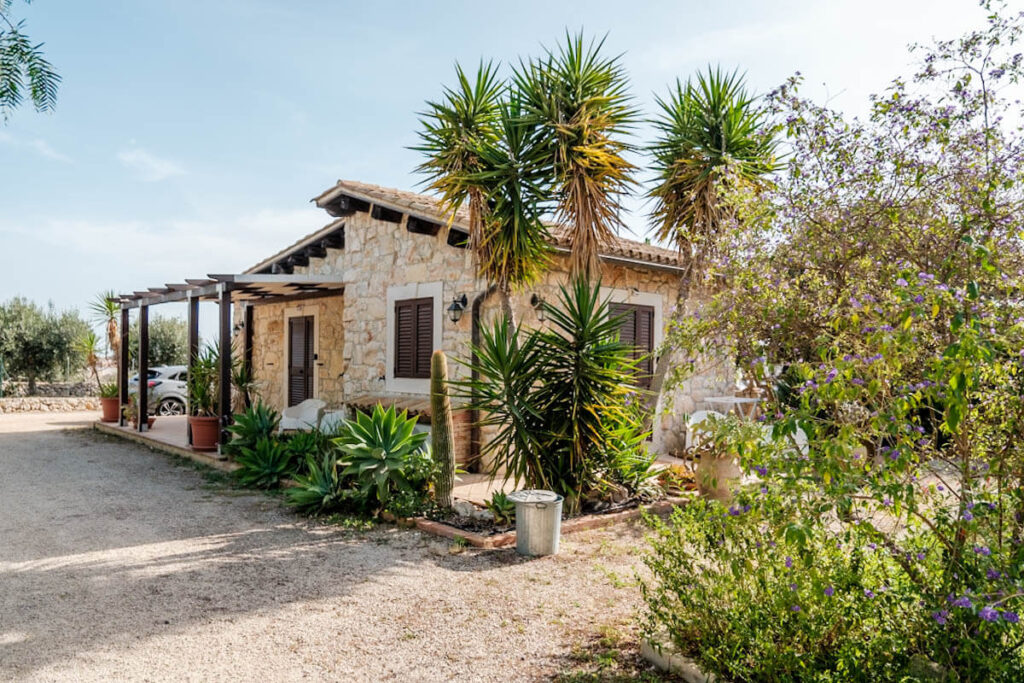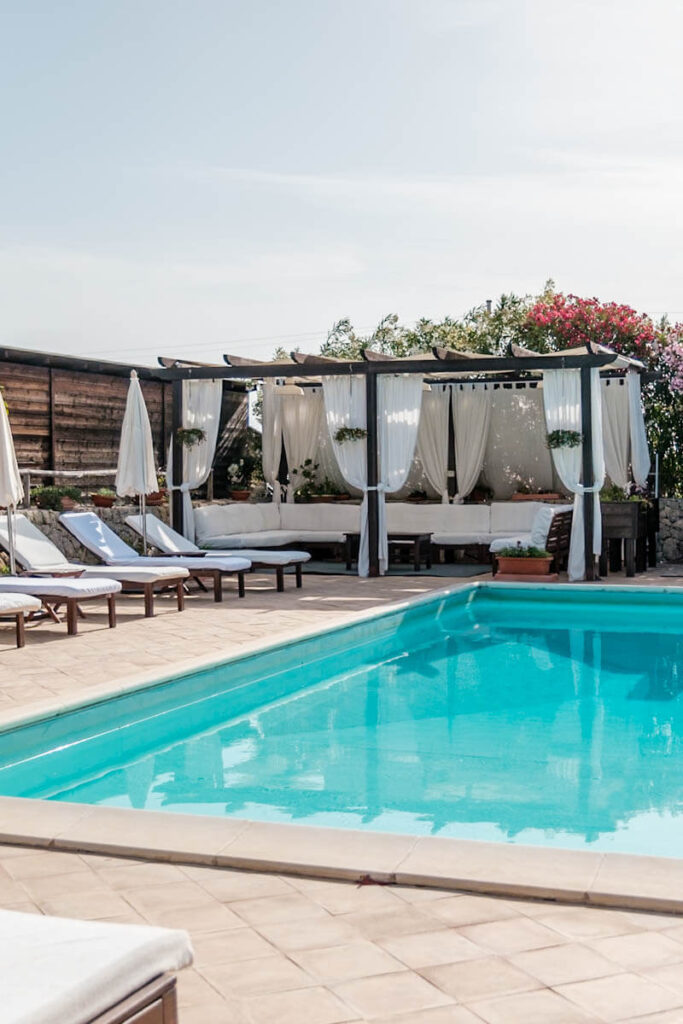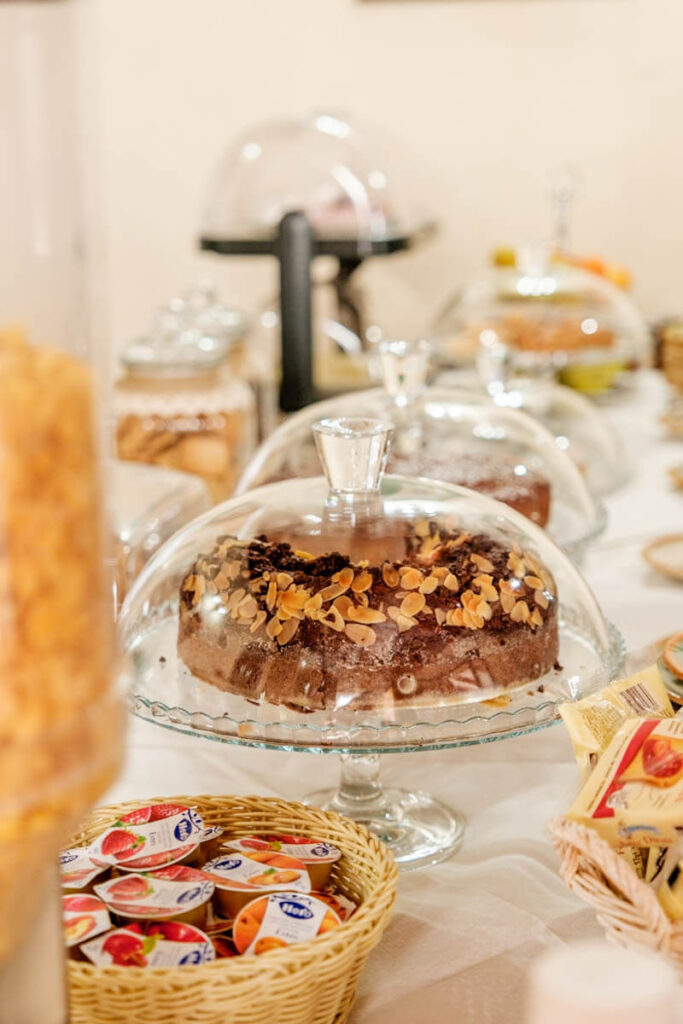When visiting the eastern part of Sicily, you’re almost certain to explore the historic center of Syracuse: Ortigia. This small island just off the east coast of Sicily is one of the top highlights in the region, alongside landmarks like Mount Etna, Villa Romana del Casale, Noto, Marzamemi, the Alcantara Gorge and the Greek Theatre in Taormina. Ortigia is a stunning corner of Sicily where you’ll be amazed not only by its monumental architecture, but also by its spectacular light, something that makes it especially appealing to photography lovers. In this article, I’ll take you on a walk through the narrow streets of Ortigia, passing some of its most impressive sights.
History of Ortigia (Syracuse)
Ortigia is a small island off the east coast of Sicily. In the 8th century BC, Greek settlers from Corinth drove out the local population, built a bridge to the mainland and founded the city of Syrakoúsai. Over the following centuries, the city grew into a powerful metropolis, rivaling Athens and Carthage. In the early 3rd century AD, it fell into Roman hands. Under Roman rule, the city became known as Syrācūsae and served as the capital of Sicilia, the first Roman province.
In the centuries that followed, the city was conquered multiple times, including by the Arabs and the Normans. At the end of the 17th century, a devastating earthquake struck the region, after which the historic center of Syracuse was rebuilt in the distinctive Sicilian Baroque style.
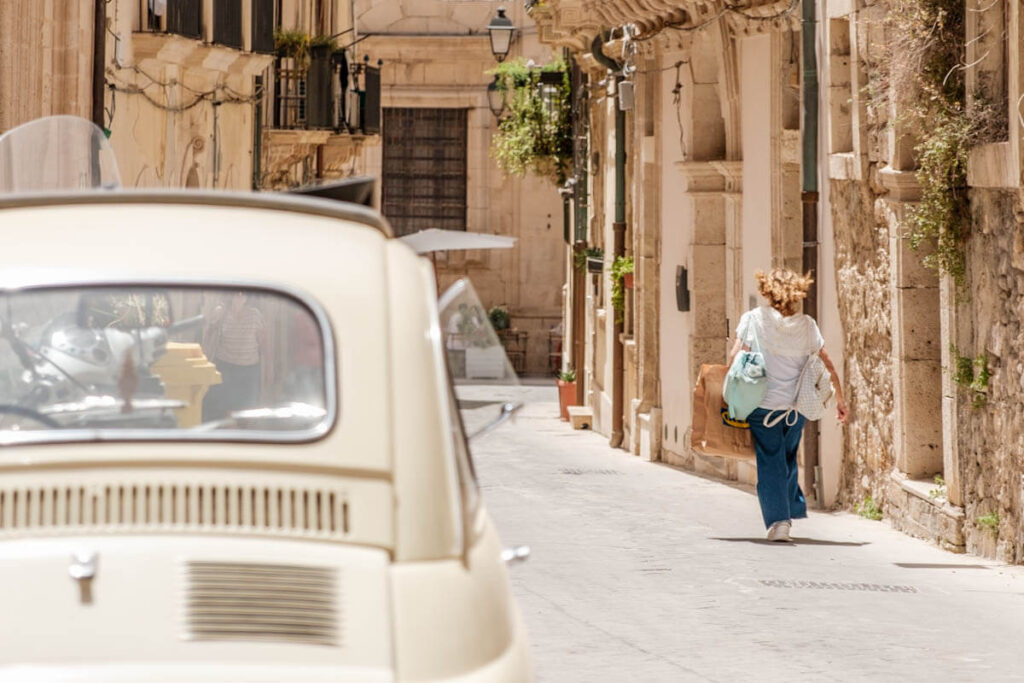
City walk through the historic center of Syracuse
Since the 1990s, much of the historic center of Syracuse has been carefully restored and in 2005 it was added to the UNESCO World Heritage List. Today, Ortigia remains the most fascinating part of Syracuse. Winding alleyways, Baroque balconies with wrought-iron railings, cozy eateries where you can sample Sicilian specialties… it’s the kind of place where getting lost is part of the charm.
But if you’d rather explore with a bit more direction, especially if you’re short on time, follow this walking route through Ortigia. It will lead you past key sights and through some of the island’s most photogenic narrow streets.
Parking in Ortigia
Parking in Sicilian cities can be a bit of a challenge and Syracuse is no exception, especially on a small island like Ortigia. Fortunately, there’s a large covered parking garage on the north side of the island: Parcheggio Talete. Here, you can leave your car in the shade and pay conveniently by card.
Forte San Giovannello
From the parking area, we walk south along the fortified walls of Forte San Giovannello, a Spanish stronghold dating back to the 17th century. From this spot, you have a clear view of the northeastern side of Ortigia and it sparks curiosity about what lies at the heart of the island.
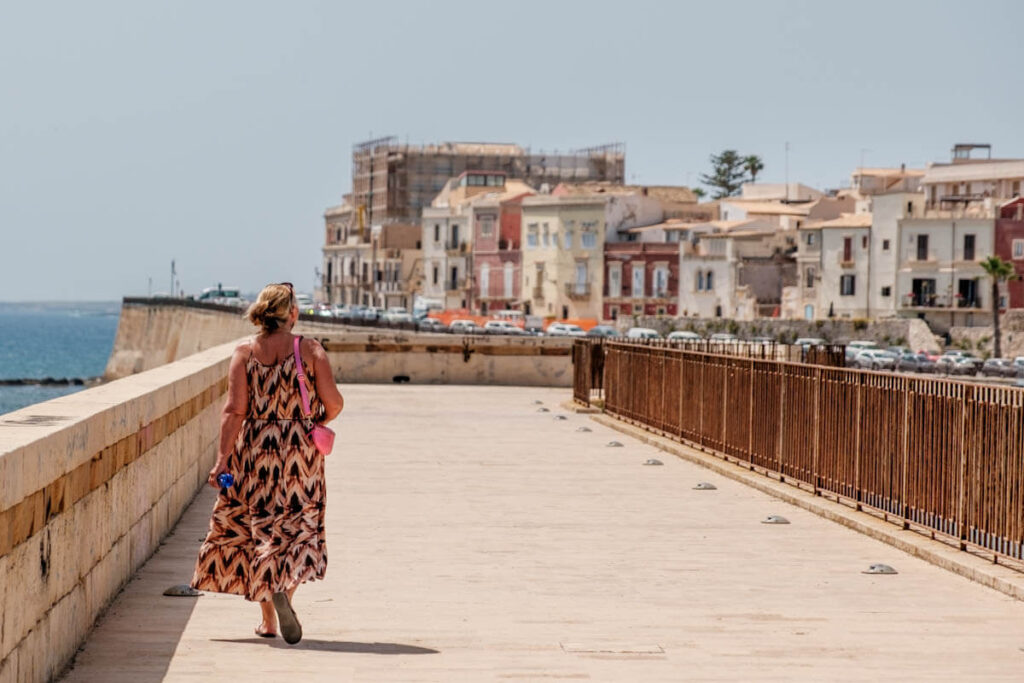
When we reach Via Vincenzo Mirabella, we turn right. Right away, the beautiful light catches the eye. The colors are absolutely stunning! At Via Tommaso Gargallo, we turn left and soon arrive at the first charming little square with a terrace.
Feeling like a treat and see an empty table? Take a seat and enjoy, it’s much quieter here than the busy terraces we’ll come across later on in the walk.
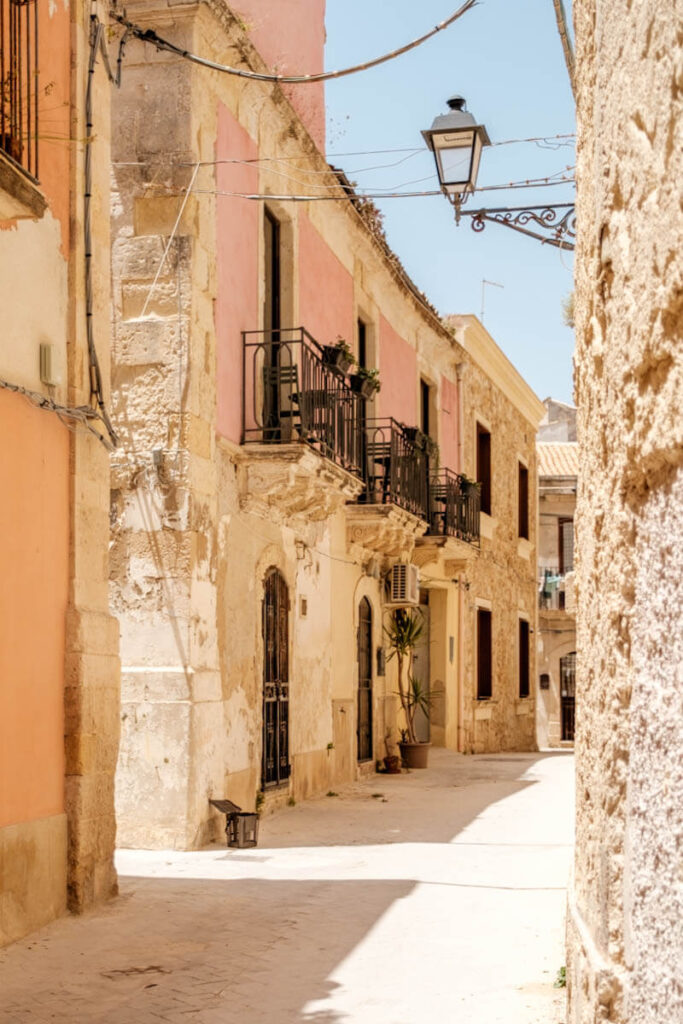
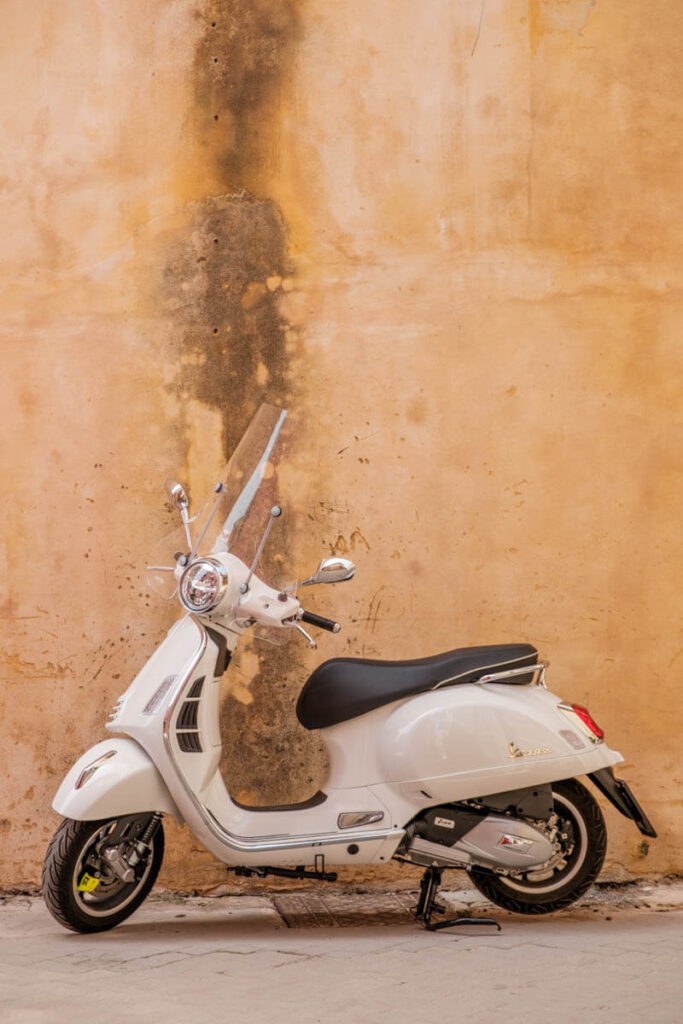
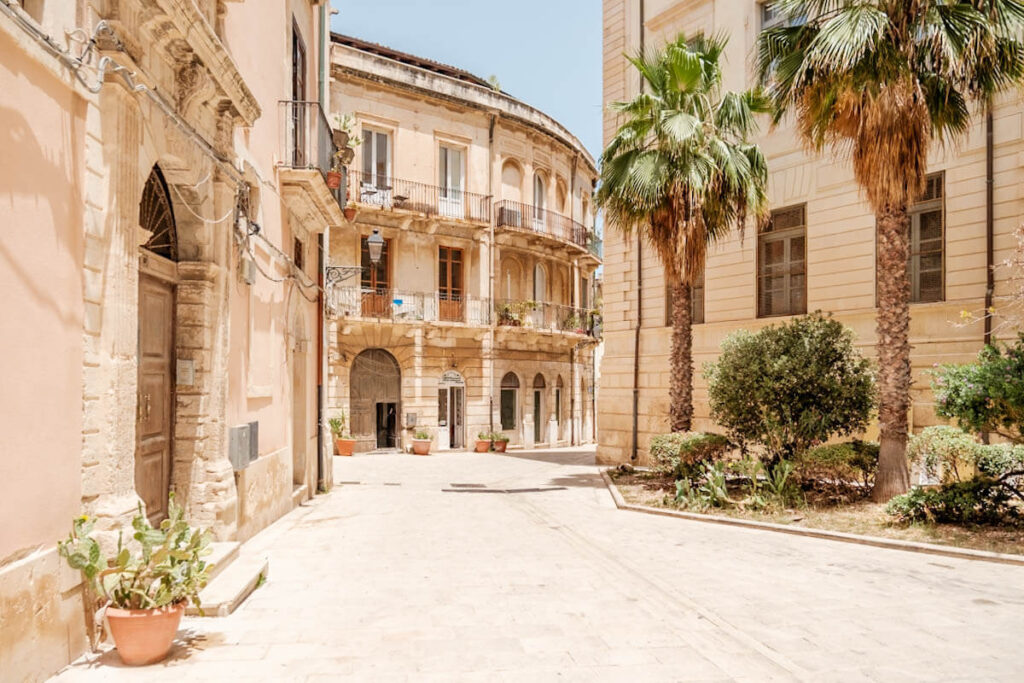
After the terrace, we turn left into Via Dei Mergulensi. Here you’ll find a beautiful little square with an excavation site uncovered in 2005. It’s believed to be part of a metal foundry dating back to the 5th century BC. Past the excavation, we turn right into the narrow alley Via Dei Montalto, which leads us to the well-known Piazza Archimede.
Fontana di Diana (Fontana di Artemide)
Piazza Archimede is home to the famous Fontana di Diana, also known as the Fontana di Artemide. This impressive fountain was created in 1907 by sculptor Giulio Moschetti. At its center stands Diana (Artemis), daughter of Zeus and Leto and goddess of the hunt. At her feet lies Arethusa and around her are several sculptures of Tritons (sea gods).
You’ll find yourself circling the fountain again and again; it’s so richly detailed that you’ll spot something new each time you walk around it.

Via Roma
This walking route through Ortigia continues along Via Roma, a broader street lined with shops and inviting eateries. Here, Baroque architecture surrounds you from every angle and the beautiful light completes the picture. As photogenic as the narrow alleyways are, this street is just as impressive in its own way!
At Via Giuseppe Logoteta, we turn left and walk straight ahead until we reach the church Chiesa di Francesco di Paola. Step inside for a moment, there are some stunning wall paintings to admire.
When you leave the church, you’ll find yourself facing the Museo dei Pupi, where you can learn all about the traditional puppets that have been crafted in Syracuse since ancient times.
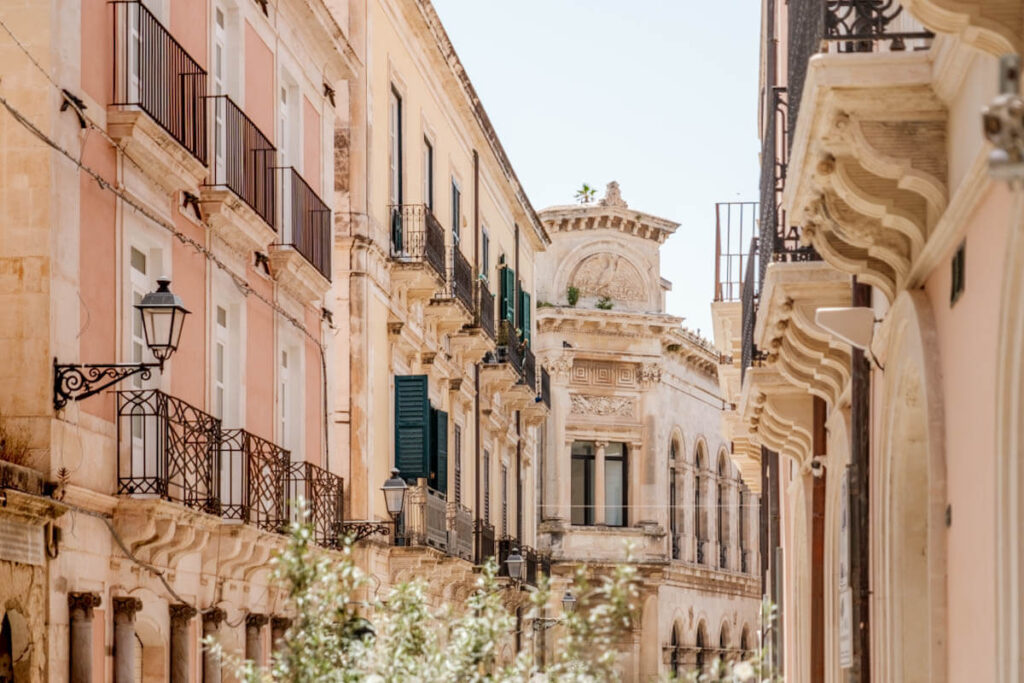
Spiaggia di Cala Rossa
After the church, you can cut through Via Mario Minniti to reach the eastern side of the island. If you want to soak up the atmosphere of more narrow streets, continue walking a little further to explore one of the alleys ahead. Once you reach the sea again, you’ll soon find Spiaggia Diana nel Forte. Here, platforms have been built in the water where you can sunbathe. Steps are attached to the platforms, allowing you to safely enter the water for a swim.
We continue walking south along the water and quickly come across another popular spot for sunbathing: Spiaggia di Cala Rossa. This small beach attracts many beach lovers and is especially ideal for families with children. The large rocks in the water create a natural barrier, keeping the water calm and clear near the shore.
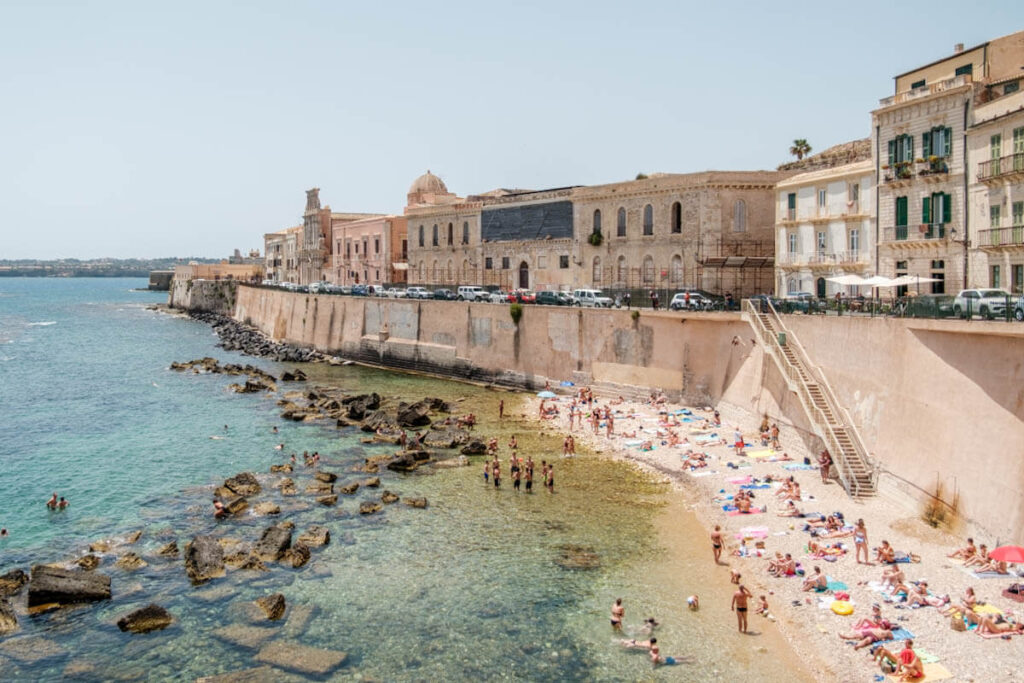
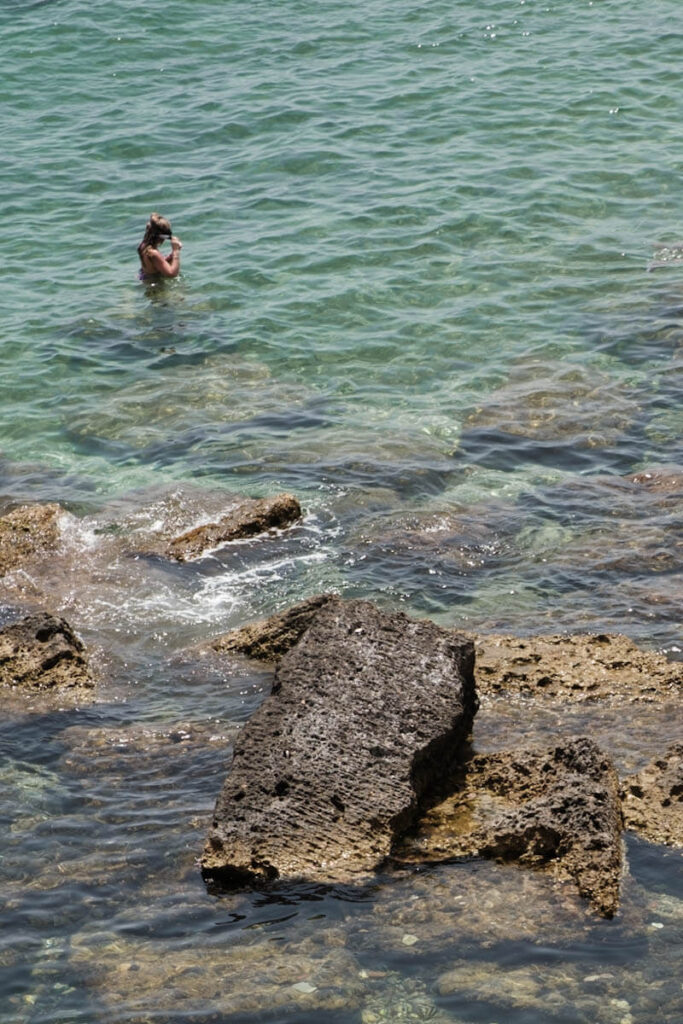
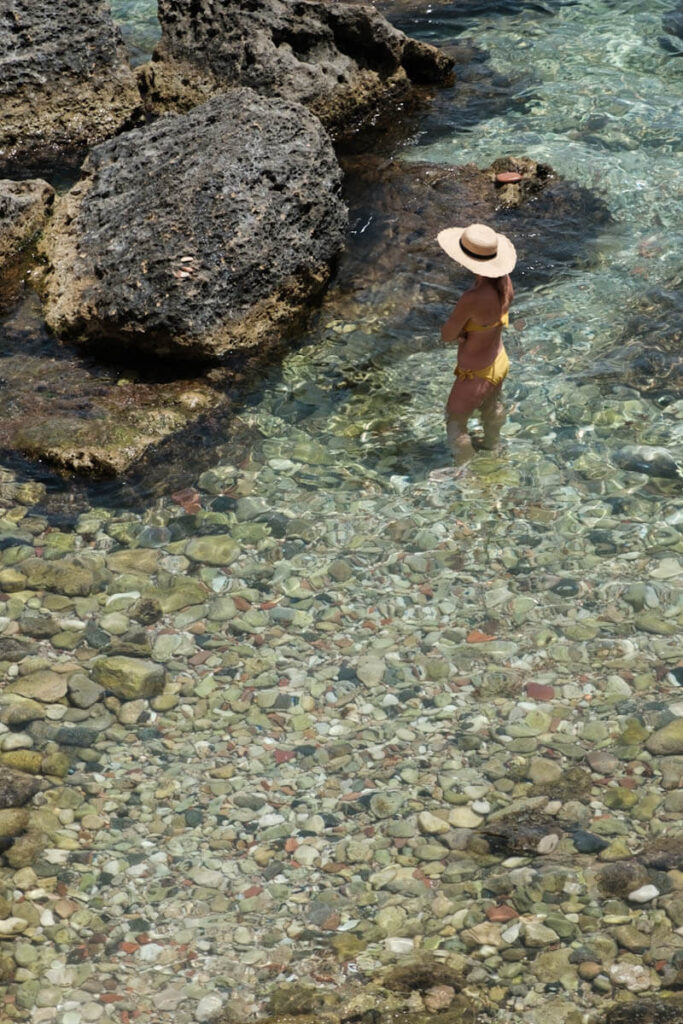
Castello Maniace
Continue the route further south in Ortigia until you reach Castello Maniace. This castle was built in the 13th century on the foundations of an 11th-century fortress. For centuries, it served as part of Syracuse’s fortifications, protecting the harbor. When its military role became obsolete, the castle was used as a prison and later as a barracks for the Italian army. Unfortunately, I didn’t have time to visit Castello Maniace—definitely a good reason to come back someday.
Via Capodieci
After visiting the southernmost part of Ortigia, the walk continues back toward the center of the island. The route is straightforward, but of course, you can wander down as many side streets as you like. I highly recommend making your way to Via Capodieci; what a charming and colorful street this is. There’s always something happening here! Cozy terraces, overflowing flower boxes on Baroque balconies and if you’re lucky, lots of colorful laundry hanging out to dry.
Trattoria La Foglia has a fantastic terrace and a delicious menu. Don’t miss this street!
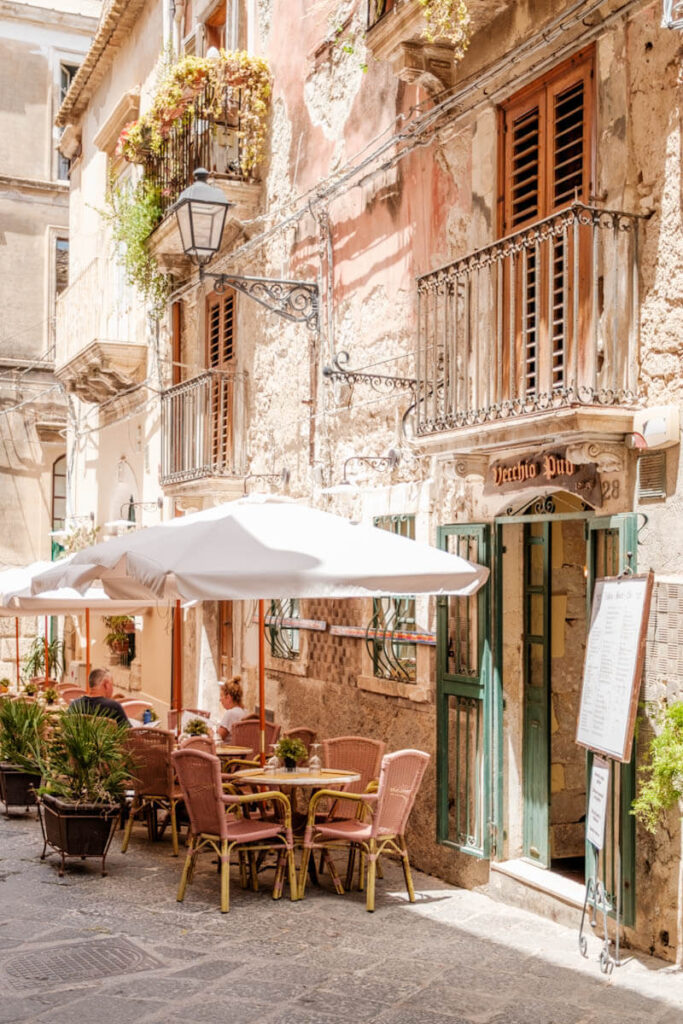
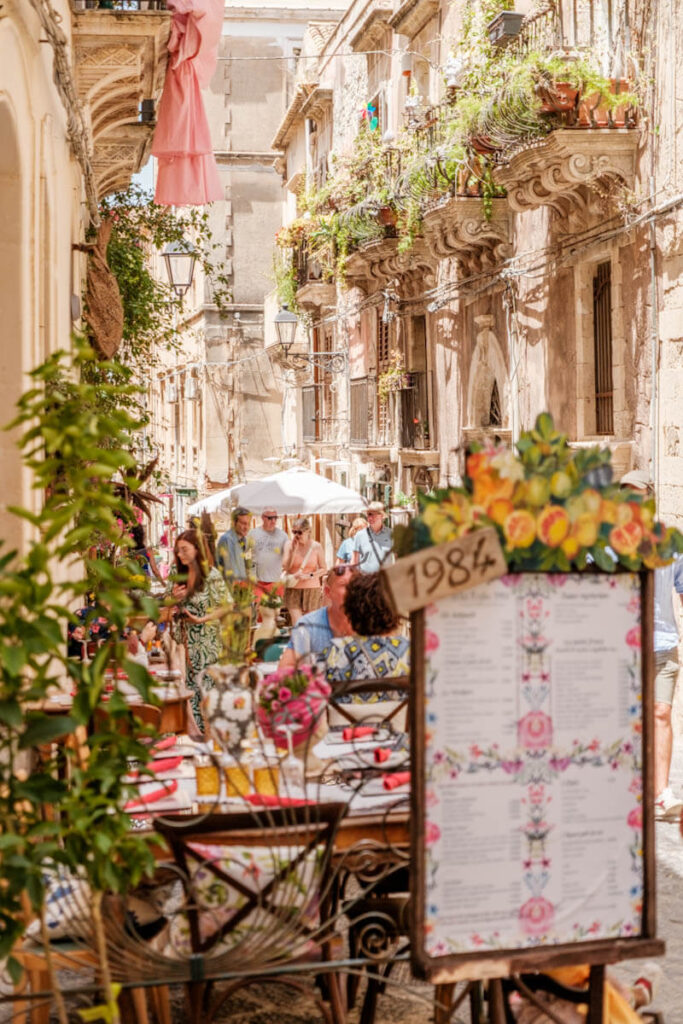
The side streets adjacent to Via Capodieci are surprisingly quiet again. It’s so nice to see how close together everything is here: both hustle and bustle and peace and calm. Here and there, a scooter waits patiently for its next ride and I also spot the very old Fiat 500 a few times. All incredibly photogenic.

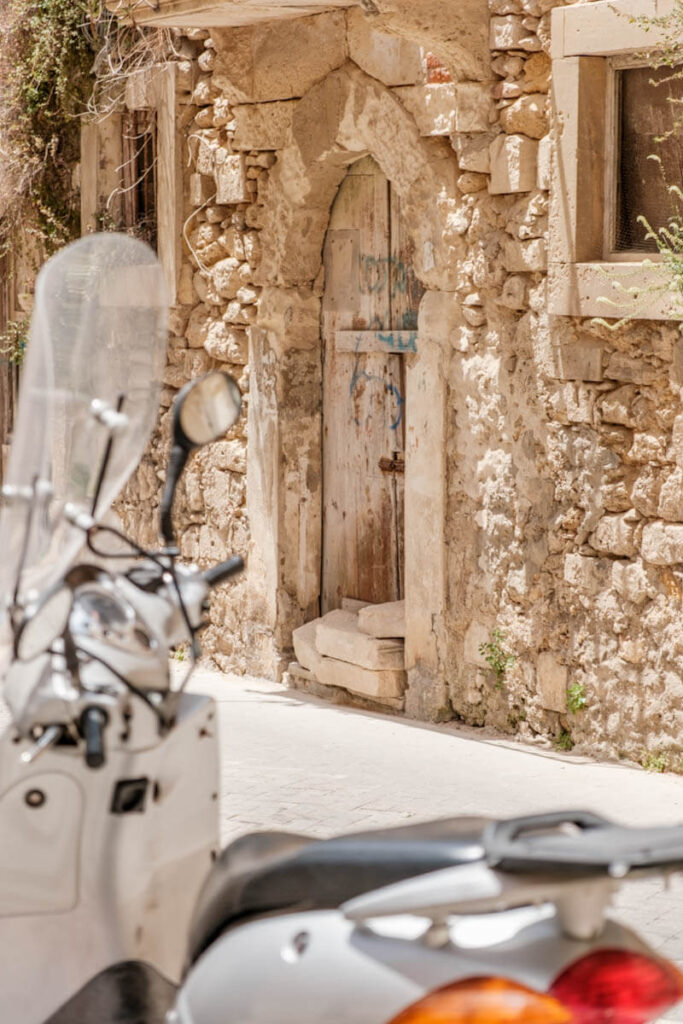
Fonte Aretusa
One well-known spot that I completely missed on this walking tour around the island of Ortigia is Fonte Aretusa. This natural spring is located at the western end of the previously mentioned Via Capodieci. It’s quite surprising that I missed it, as it’s a fairly large body of water.
Papyrus grows in the spring, a type of African reed that only grows naturally in Europe here in the spring of Syracuse and in the nearby mainland marshlands. The Belvedere di Largo Aretusa platform next to the spring is a remnant of the old bastion, which was demolished in the second half of the 19th century. From here, you have a beautiful view over the bay of Syracuse.
Marina di Ortigia
If you walk north from the spring with the water still in sight, the harbor comes into view. This area is mainly home to the larger yachts, making for a beautiful sight with the city of Syracuse in the background.
Before the parking lot, we turn right and immediately keep right. We walk around the buildings (heading south again) and follow Via delle Carceri Vecchie all the way to the end.
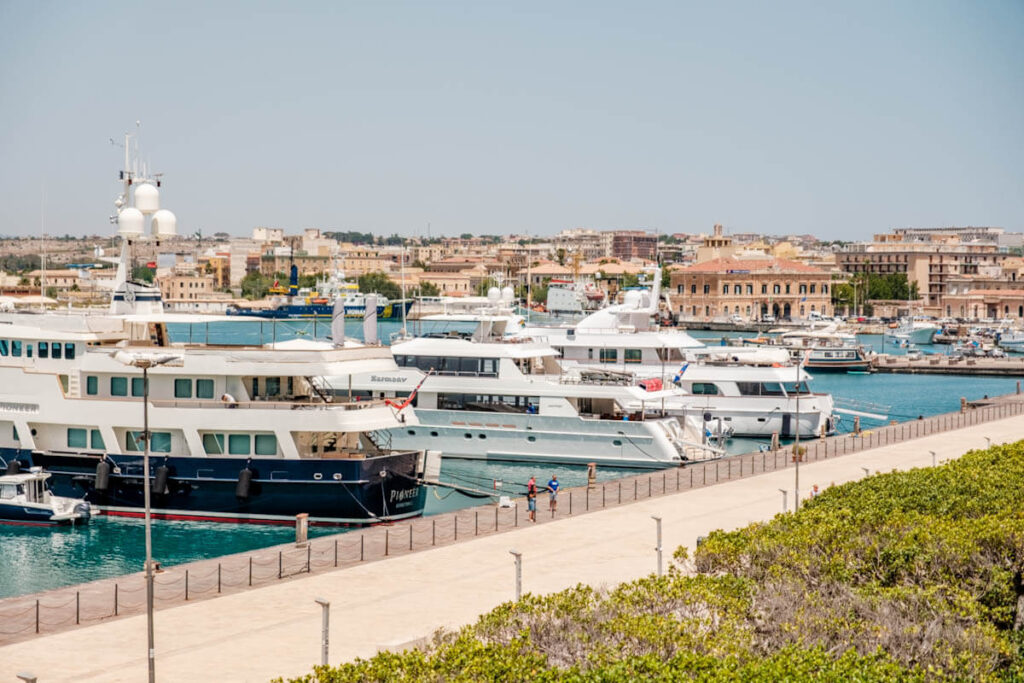
Piazza Duomo
We arrive at the most impressive place in Ortigia: Piazza Duomo. This elongated square is home to several city palaces and, of course, the Duomo di Siracusa, the cathedral of Syracuse. Other beautiful buildings on the square include the Palazzo Municipale (town hall), Palazzo Arcivescovile (archbishop’s palace and library) and, of course, Chiesa Santa Lucia alla Badia.

Duomo di Siracusa
The cathedral of Syracuse, also known as Santa Maria del Piliero or Santa Maria delle Colonne, was built on the remains of the (Greek) Temple of Athena dating back to the 5th century BC. Some parts of the original temple are still visible, such as the columns along the long side of the cathedral.
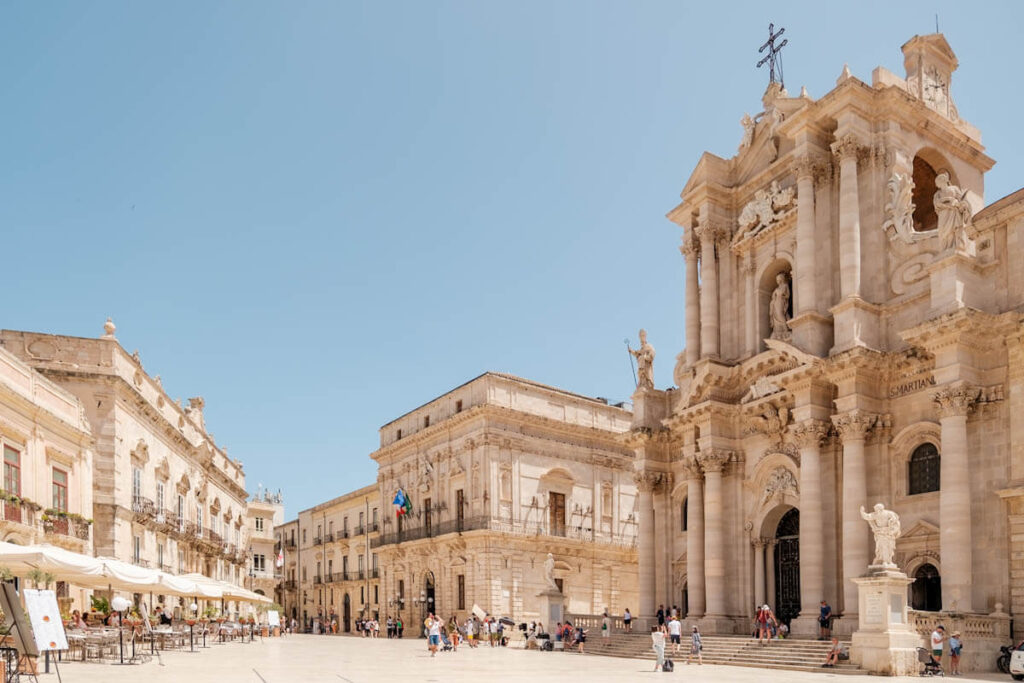
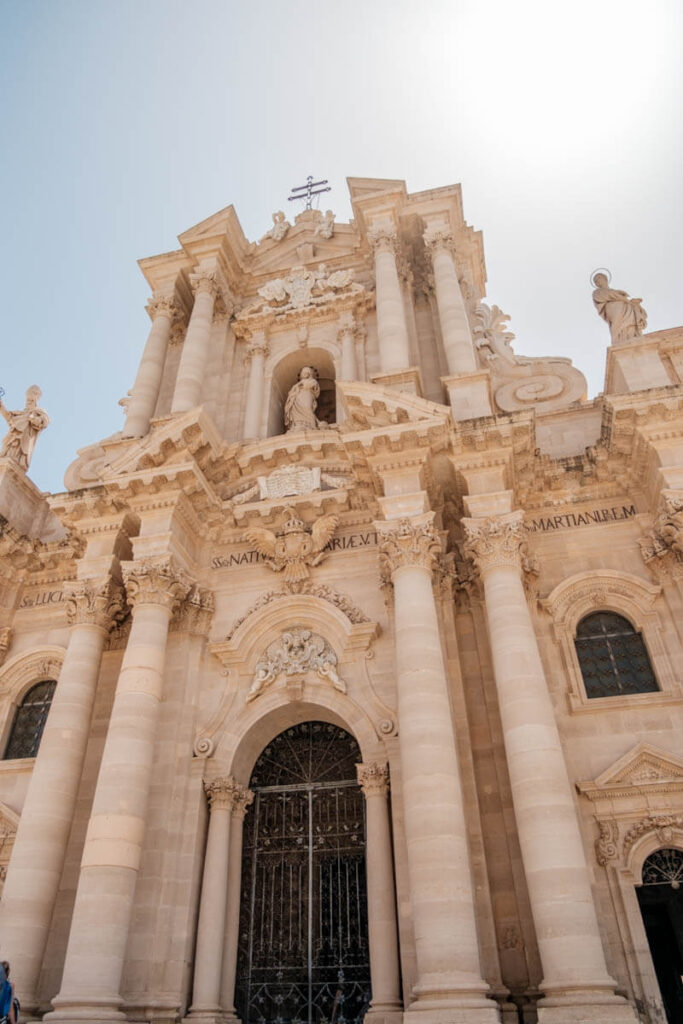
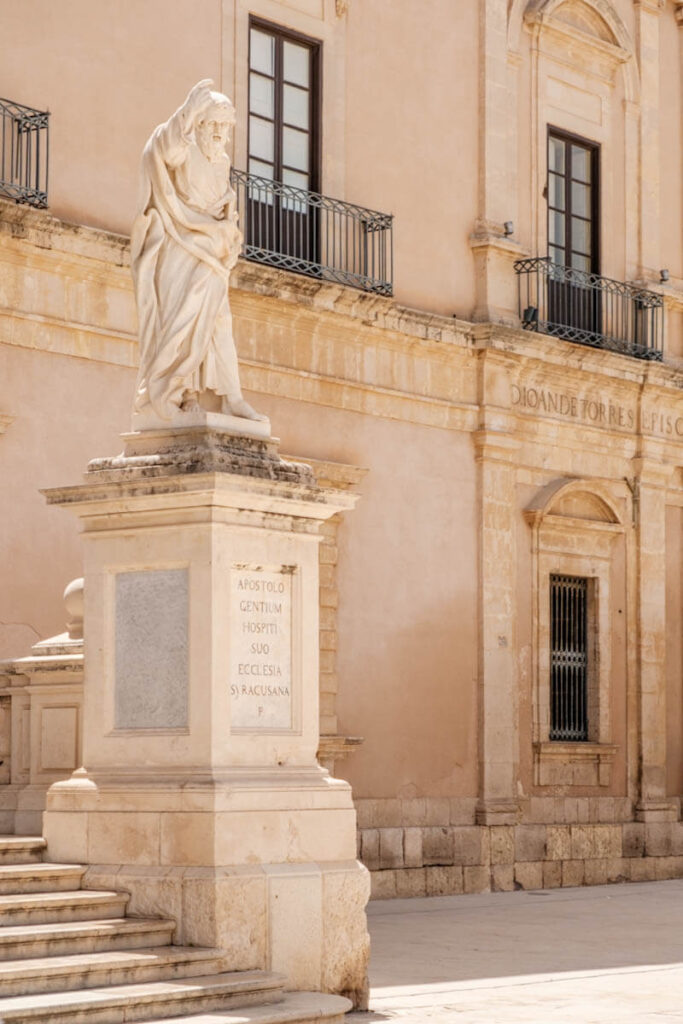
Chiesa Santa Lucia alla Badia
If you are a fan of painters, a visit to this church is definitely recommended. Inside, you can see a famous work by the Italian painter Caravaggio: The Burial of Saint Lucy.
Piazza Duomo is a place where you could easily spend quite some time. It takes a while to take it all in, there is so much to see. Besides, there are plenty of terraces. And what could be better than enjoying a nice drink with a beautiful view?
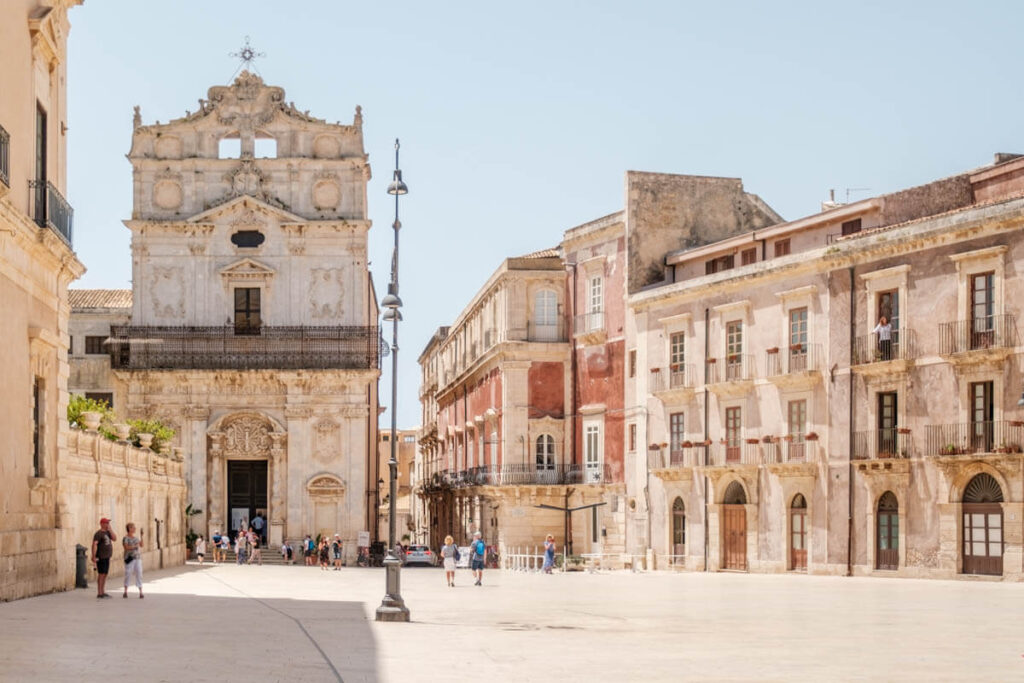
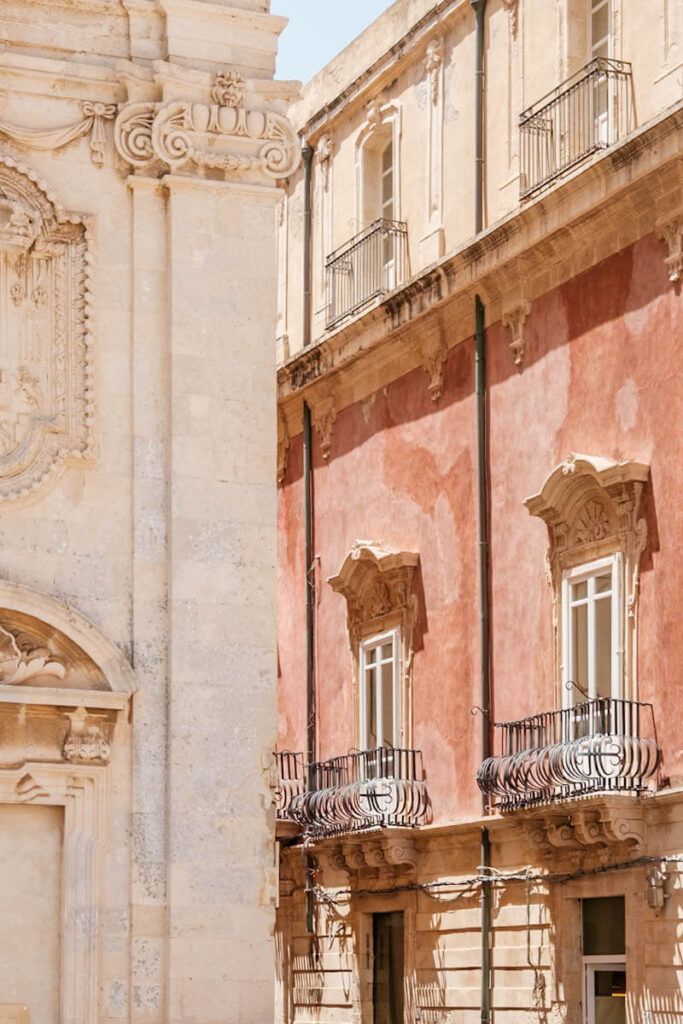

Via Saverio Landolina
If you walk north from Piazza Duomo, you’ll arrive at the charming Via Saverio Landolina. If there’s anywhere that feels lively, it’s here! From this spot, you don’t quite have a view of the square, but that doesn’t spoil the fun. Here too, you find yourself surrounded by beautiful baroque architecture, plenty to admire.
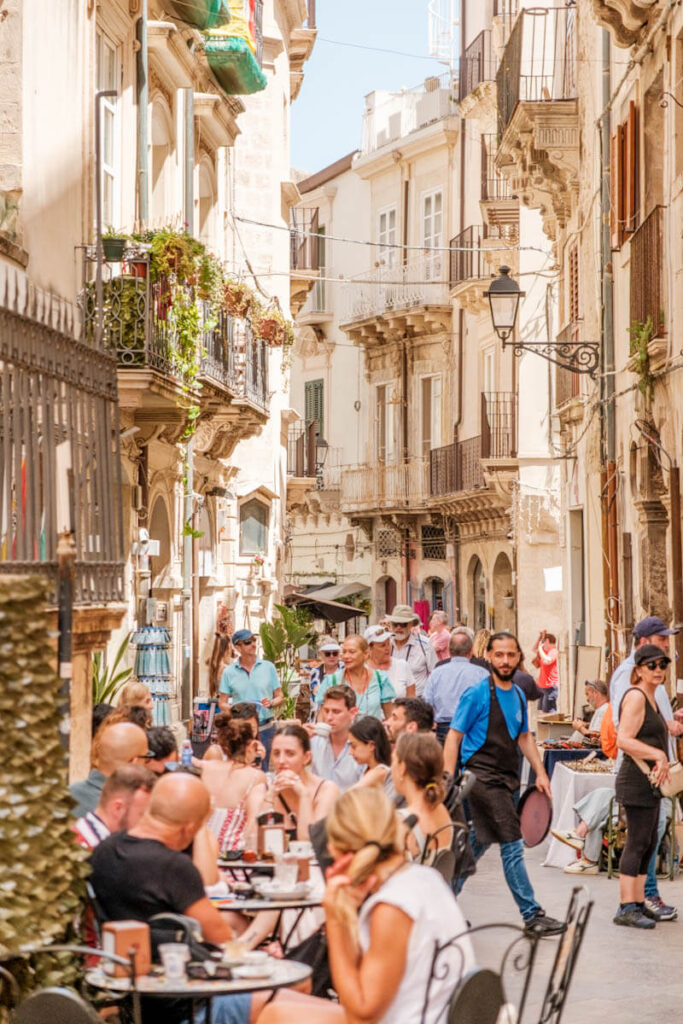
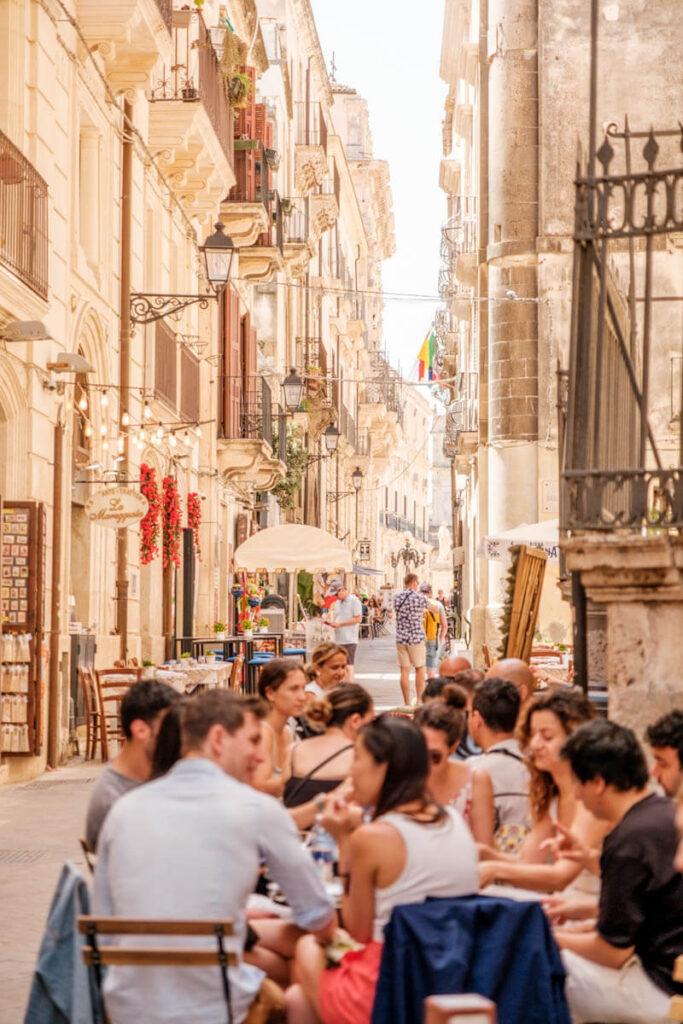
Tasting Arancini and Cannoli
Continuing north along Via Saverio Landolina, we turn right onto Via Della Amalfitania. This is one of those typical streets where you can enjoy all kinds of Sicilian specialties. Think of Arancini (fried rice balls filled with various ingredients) and Cannoli (pastry shells filled with ricotta cream). Absolutely delicious! Small tables line both sides of the narrow street, where you can sit down to enjoy a drink and one of these Sicilian treats.


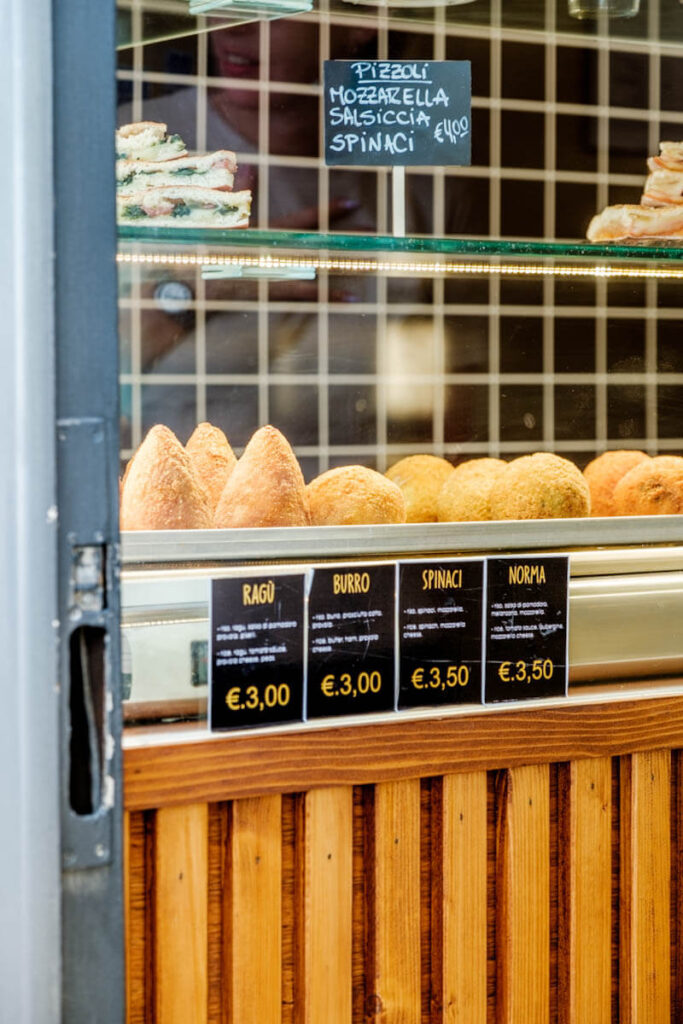
Via Domenico Scinà and Via Gemmellaro
The route leads back to Piazza Archimede, near the famous fountain. We keep left and turn into the next street: Via Domenico Scinà. This is another alleyway with cozy restaurants. For a glimpse of a street without restaurants but full of everyday life, cross the next street where Via Domenico Scinà turns into Via Gemmellaro. Here, the scene is defined by hanging laundry, flower boxes, parked scooters and playing children. Suddenly, you feel like you’re walking off the beaten tourist path.
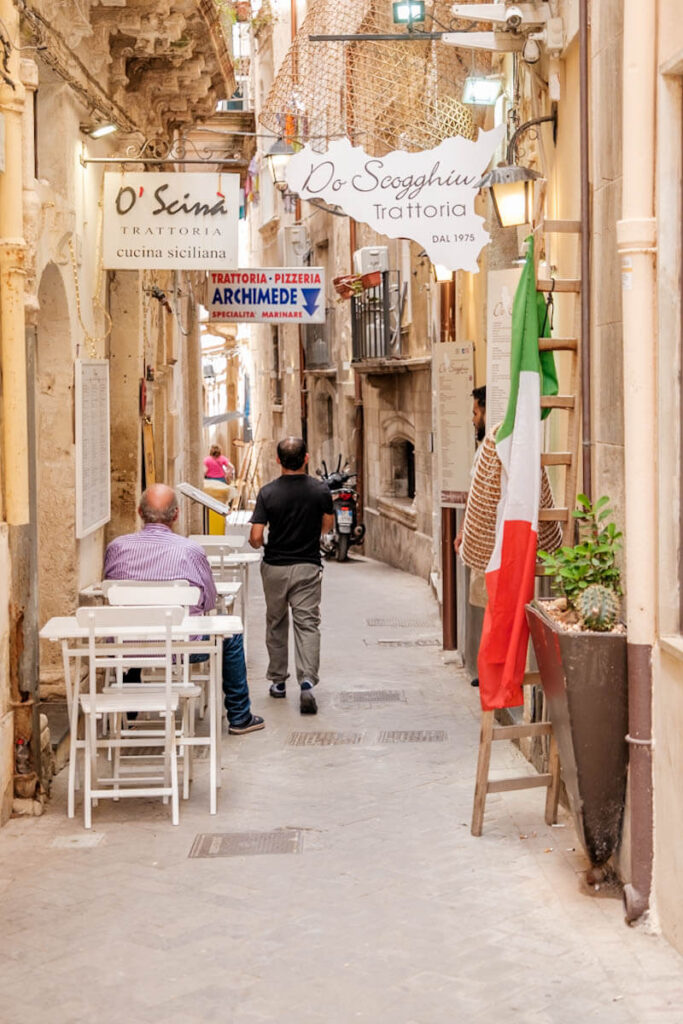
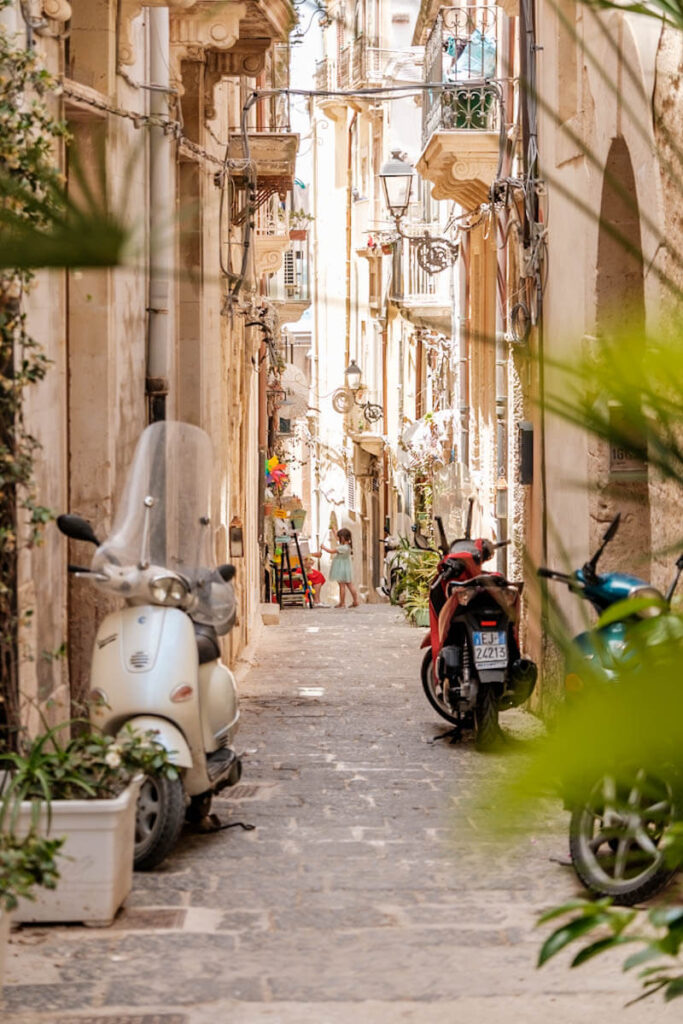
Via Dione
Walk back through the same alleys or take some different streets back to Piazza Archimede. From there, cross the street and turn onto Via Dione. This quiet, long street is full of baroque balconies with wrought-iron railings. You won’t be able to stop photographing here! Small terraces appear here and there, but you can really feel that you’re well off the tourist path. Be sure to explore some side streets or alleys along the way. Got time? Then enjoy getting a little lost, you’ll discover the most beautiful spots that way.
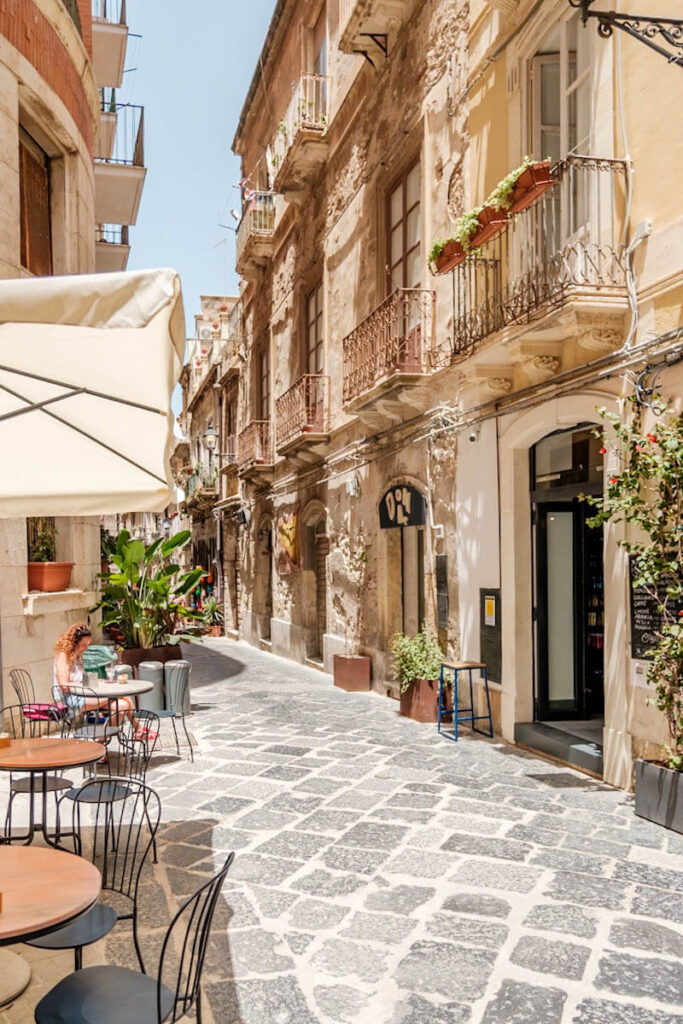
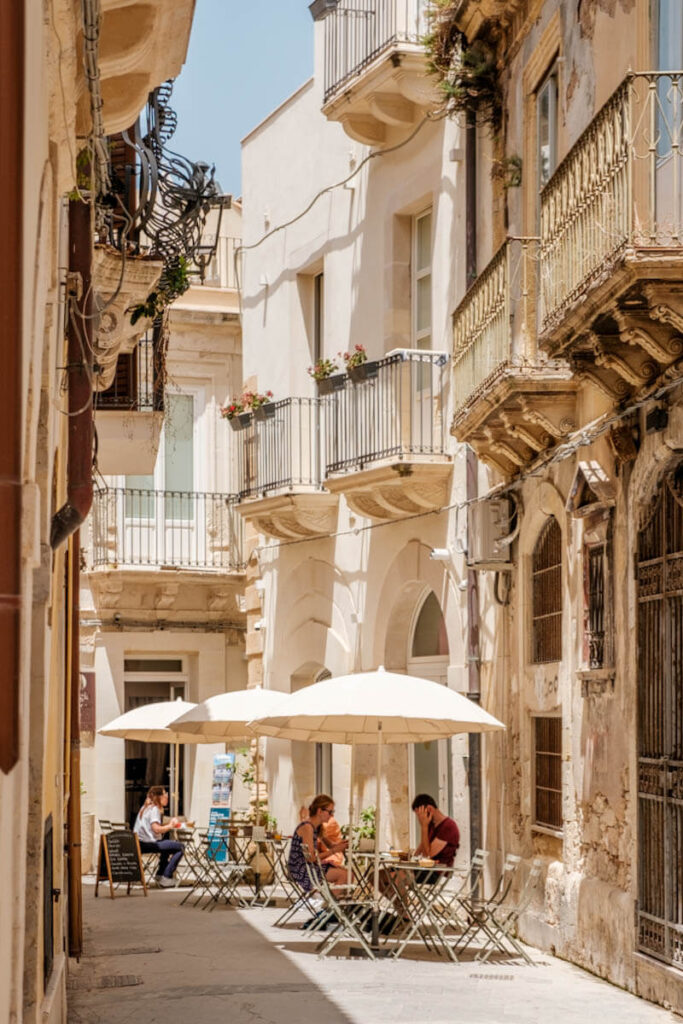
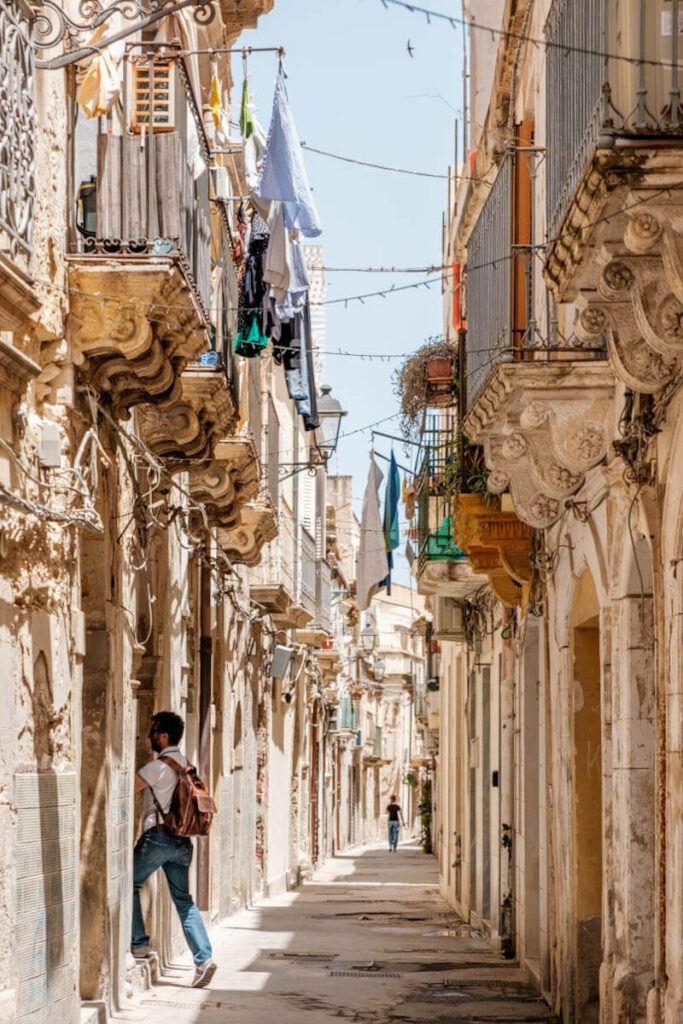
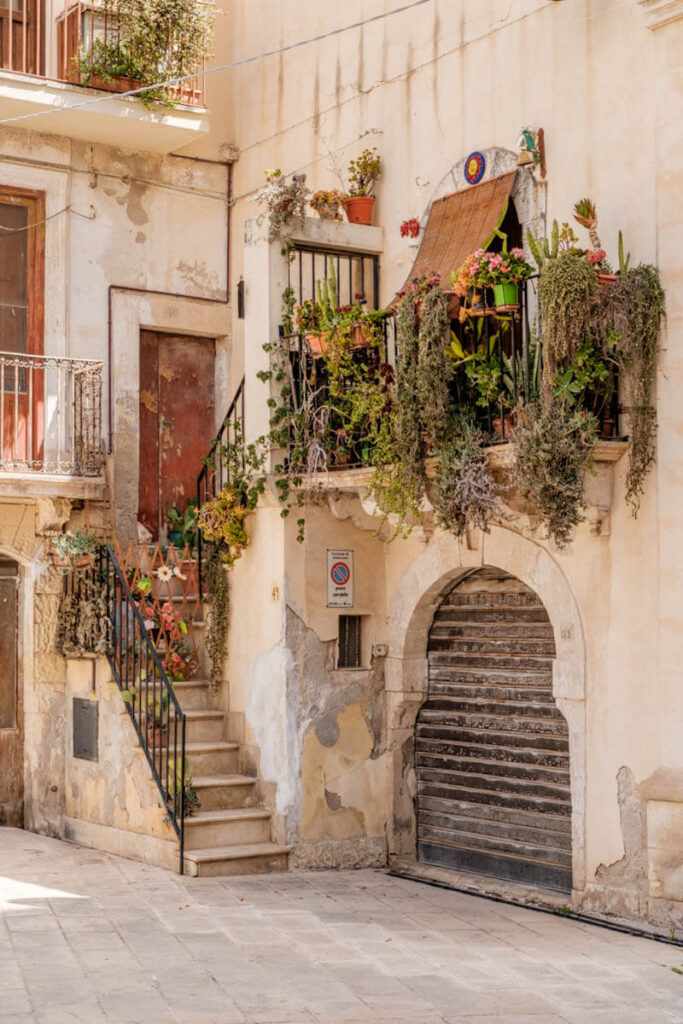
Tempio di Apollo
Via Dione is quite a long street. At some point, you can turn left and immediately see the remains of the Tempio di Apollo: the Greek temple of Apollo. This temple was built in the 6th century BC by the Greeks. The structure served many purposes over the centuries, first as a temple, then later as a church and even as a barracks.
You can almost walk all the way around the temple complex, which also leads you to the street market of Ortigia. The market is known for selling regional products and Sicilian specialties. Take your time wandering through the market and if you feel like it, stroll all the way to the end of the street. If you’ve had enough after a few market stalls, simply cut back to Via Dione. Walking the full length of this street will bring you back to the parking area.
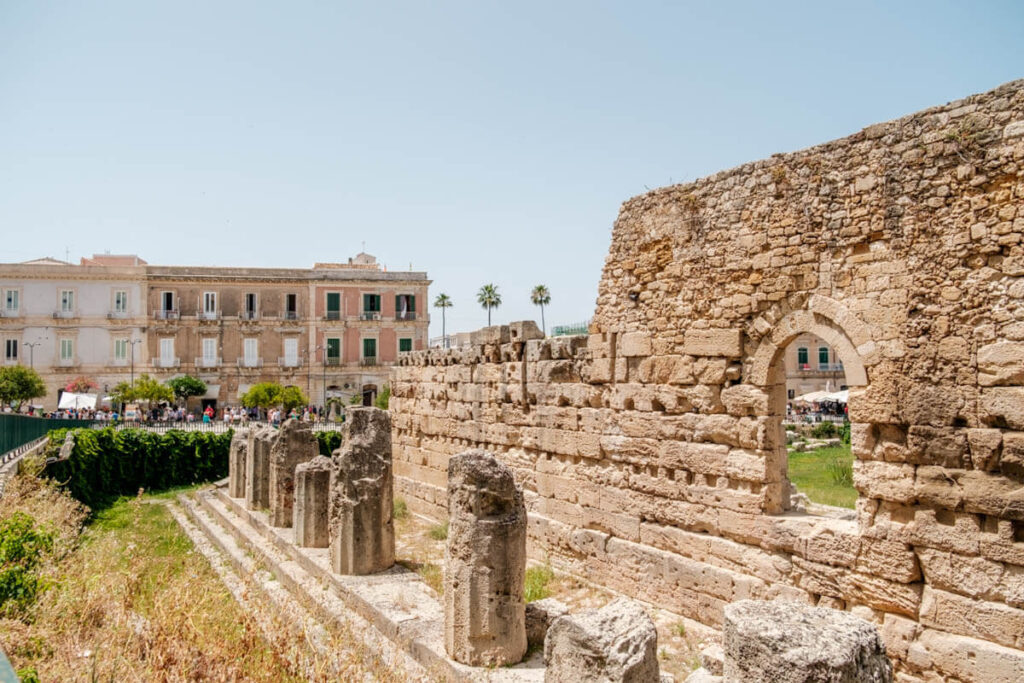
Accommodation near Ortigia
Staying overnight in Ortigia is truly special, but it can be a bit challenging when you have luggage. You’ll need to park your car at the edge of the island. This isn’t a problem if your accommodation is close to one of the parking areas, but it can be inconvenient if your lodging is closer to the city center. On top of that, parking fees can add up quickly.
I personally stayed at B&B Villa Giusy, a beautiful and peaceful bed & breakfast located about 11 kilometers from Ortigia. The beds were incredibly comfortable, the host was very kind and the breakfast was extensive, with homemade cakes among other treats. I could easily have stayed for a few more nights!
